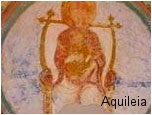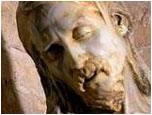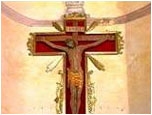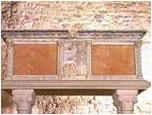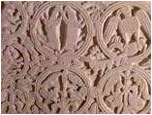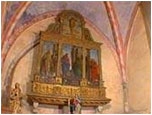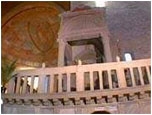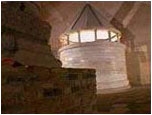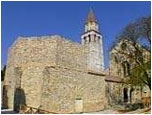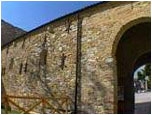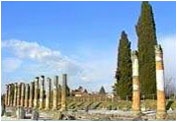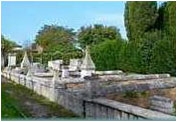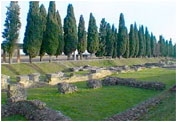Visit the city>More artworks in the Basilica of Aquileia
In the central part, in an almond, depicting the Madonna and Child and around the symbols of the four Evangelists. On the sides of the Saints Ermacora, Fortunato, Euphemia, Mark, and Hilary and Tatian, smaller, Emperor Conrad II together with his family, the Duke of Carinthia and the Patriarch Poppo in the act of offering to the Virgin Mary the model of the church to him renewed. In the lower part are represented eight Saints; further down a long inscription commemorates the consecration of the Church on 13 July 1031.Forum magna (late fifteenth century)
Sculptural work of great elegance and refinement performed by Bernardino da Bissone.
Sarcophagus of the saints Canziani (XIV century)
And most likely an altar frontal Gothic style with Christ at the center and sides of the Saints Canzio, Canziano Canzianilla and Proto.
Christ of the trench
Marble bust of extraordinary expressive force carved by a soldier artist, Edmund Furlan, during the First World War.
Crucifix of the sixteenth century
2.15 m high and recently restored propitiatory was carried in processions to pray for rain or whatever.
Sarcophagus of St. Mark Pope said of the fourteenth century
Supported by four columns by Filippo de Sanctis. On the front a bas-relief depicting St. Ermacora with the four virgins Aquileia: Erasma, Euphemia, Tecla and Dorothy. On the back: Christ between two donors.
Plutei Massenziani
Sheet or barriers that enclose the chapel right now dedicated to S. Peter and originally bordered the presbytery erected by the patriarch Maxentius.
Altarpiece pilgrim from San Daniele (1503)
Once adorned the apse above the patriarchal chair with the function of the altarpiece. They are represented Saints Peter and Paul, Ermacora and Fortunato, Mark and Theodore, dominated from above by the figure of the Saviour.
Torrianidel Chapel of the thirteenth century
It houses the sarcophagus of some patriarchs of the family of the Tower, it is dedicated to S: Ambrose.
Pietà or Vesperbild
Colored stone, is located within the niche of S. Jerome.
Our Lady of milk or of ‘humility
Istrian stone is painted in the late Romanesque style.
Holy Sepulchre of the eleventh century
Reproduction of S. Sepulchre of Jerusalem as it was described by early medieval historians and travelers. It was used for the liturgy of Holy Week.
Baptistery of the fourth century
Located opposite the main entrance of the church has an octagonal and hexagonal tank interior (characteristic of Aquileia and areas affected by its evangelization).
Portico church and the pagan gods of the ninth century
The patriarch Maxentius had erected on the porch in front of his church to connect to the baptistery through a closed building with two floors, the so-called “Church of the Pagans.”
The Roman Forum
The hole, now crossed by the Via G. Augusta, was the city’s main square. It dates back to the second century. A.D. Surrounded by arcades, under which there were shops and public rooms for city council, treasury and archives, here they held their public meetings and assemblies. In the adjacent basilica forensic debating the causes and business.
The cemetery
In Roman times the tombs had to be placed by law outside the city walls, from which came the costume to align along the main streets, called sepulchral ways. In the excavations the stretch of burial visible today includes five burial areas surrounded by a fence, each of which belonging to a family. It dates from the middle of the first century. d. C. and the beginning of III ca. and is the only example of a Roman cemetery found in Aquileia.
The river port
Along the Via Sacra are the ruins of the port built probably in the second century. BC, later expanded and renovated several times. The river opened with a 48 meter wide bed and was flanked by solid piers 350 meters long and impressive magazziniLungo the Via Sacra are the ruins of the port built probably in the second century. BC, later expanded and renovated several times. The river opened with a 48 meter wide bed and was flanked by solid piers 350 meters long and imposing warehouses.
Case Roman and early Christian speakers
Currently visit two archaeological sites with mosaics of houses dating from the first century. BC and the fourth century. A.D.
Great Mausoleum
Reconstruction of the tomb of an unknown municipal magistrate dates back to the age of Augustus (27 BC – 14 AD).

